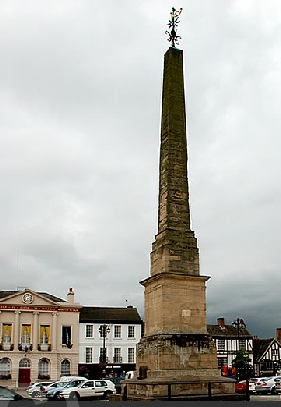



The Parish Church of St George the Martyr, Waterlooville

Memorials 4. Ripon, Yorks
Whilst on holiday in North Yorkshire this summer my wife and I spent an afternoon in Ripon. After visiting the cathedral we strolled to the city centre. We soon discovered a spacious town square in the centre of which stood a tall obelisk. I suspected this might be the Ripon War Memorial or possibly a monument commemorating some politician or local worthy. Closer inspection, however, revealed it to be something much more unusual. Designed by Nicholas Hawksmoor it was erected by the town council in 1702 to commemorate the Ripon Hornblowers who date back to the reign of King Alfred in 886.
Having defeated the Danes in battle Alfred toured the country to confirm his victory. He visited Ripon, then a small settlement, granted a Royal Charter and presented the people with a horn as a symbol of that charter. He urged the people of Ripon to become more vigilant in case the Danish Army returned. As a result the townspeople appointed a wakeman to patrol the area at night. Each evening at 9 o’clock the wakeman was ordered to sound the charter horn at the four corners of the market cross to let the people know the watch was set and all was well. The wakeman was paid and this was funded by a small tax, 4d a year, if your door faced the market square but only 1d if your door was down a side street. This continued until 1604 when James I granted a second charter and Mr Hugh Ripley became the first Mayor. He also instructed the wakeman or Hornblower as he was now called, to report to him every night, blow the horn three times, bow and say “Mr Mayor the watch is set”. Remarkably this ritual has been carried on unbroken every since.
So just before 9 o’clock we returned to the square to watch the ceremony. At first all was quiet and nothing seemed to be happening. Then out of nowhere the present Hornblower, Mr George Pickles, appeared. Wearing a black tricorn hat plus a smart grey uniform with red epaulettes and the hornblowers insignia on his sleeve he carried a long curved brass bound horn. He slowly perambulated around the obelisk and blew the horn four times. By this time a small curious crowd had gathered. He then beckoned everyone towards him and then for 15 minutes or so told us the story of the 1100 year old tradition.
The inscription on the obelisk today relates to the restoration of the obelisk in 1781 by William Aislabie to celebrate his 60 years of service as MP for Ripon. High up on the north face of the monument a plaque lists all the hornblowers since 1804, the first name appropriately being a man called Simmons.
John Symonds
Christmas Edition 2011
The Ripon Obelisk
